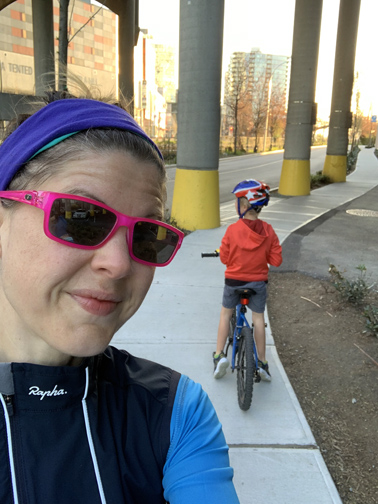Life’s normals have been turned upside down and twisted every which way with Covid-19 – my running schedule is case in point.
As a person with type-1 diabetes, I have been trying to limit my exposure to people other than my immediate family as best I can to keep as healthy as I can. That means my running times have had to change.
It all started with quarantine.
Rather than run at a normal waking hour, I was running with the morning birds, before the sun rose, and with the moon still bright in the dark blue sky. I was running with a headlamp, on roads absent of people. I was running before breakfast, before bolusing. I was running fasted.
This is not my normal.

Years ago, when I was still on maternity leave, and was training for yet another half marathon, or three, I often ran in those early hours as it was the only time I felt to be mine. But as the years passed, when I started back at work, and then later became a commuting, full-time student, those early morning runs were no longer feasible.
I grew to love running 2-3 hours post breakfast, and most of my tried and true strategies for managing my runs with my diabetes are during that sweet spot window.
But these days, that’s not always attainable.
I now have a 7-year-old dealing with the new normal of homeschooling.
Our backyard/boardwalk/easy running route when I want to stay close to home is now more populated come 10 a.m. than I’ve ever seen it in the 11 years I’ve lived here.
If I’m to avoid people, these ridiculously early fasted runs are my only option.

There are some T1D camps that love running fasted, and others that loathe it.
What does the science say?
Surprise, surprise (note the sarcasm), while there is extensive research on training low strategies for a non-diabetes population, there isn’t a lot of research in this area for athletes with type-1 diabetes. And the research that is available uses small sample sizes, which means it may not be representative of the larger T1D population.
For athletes without diabetes, research has shown that training low with reduced muscle glycogen stores and competing high with increased muscle glycogen stores can be beneficial for muscle adaptation.
Essentially, it can help athletes increase their endurance capacity and reduce the time it takes to bonk!
Using a sample size of 14 non-active individuals with T1D, a 2018 study1 showed that moderate to intense aerobic activities (ie. running, cycling, swimming) for a duration of 30 minutes was beneficial in reducing risk for hypoglycemia during exercise, as well as reducing the risk for post-exercise lows throughout the day, and aiding in optimizing BG stability.
Sounds great, but there are limitations.
Limitations:
- This study didn’t analyze aerobic exercise beyond 30 minutes; we don’t know if longer training sessions would have similar results or not.
- The population used was sedentary, which has different metabolic expenditures than an active population. Other research has shown that the more fit a person with type-1 is, the higher the risk for hypoglycemia2.
- The sample size is too small
Based on train low research from the non-diabetes population, a 2019 review3 hypothesized that training fasted may aid in reducing the increased BG effects of dawn phenomenon. However, this would likely be more beneficial for aerobic activity, as aerobic sport pulls blood sugars down, rather than anaerobic activity (weights, intense intervals), which can increase blood sugars due to the activation of stress hormones.
Limitations
- These assertions are based on a non-diabetes population.
- They are still hypothesized, but not yet proven to be true.
For me, running fasted works – to a point.
If I’m just going out for a quick, tempo-paced run, and if my blood sugars are anywhere from 6.5-11 mmol/L, I’m not concerned about drastic blood sugar fluctuations. If I’m doing speed intervals or hill repeats, I’d want my starting blood sugars to be between 4.5-7.0 mmol/L; anything higher and I’d worry about my blood sugars rising too high.
Here are my major issues with training low:
I love eating breakfast first thing in the morning, and I hate feeling hungry, so generally I don’t do anything longer than 5-7 km fasted, which means longer training runs are out.
I also (warning: potential TMI to come) typically have a bowel movement in the first hour of waking. If I’m running in that hour, that added bouncing motion, triggers the need fairly quickly, which again keeps the runs short.
Still, we’re all making sacrifices these days, and this is one of mine.

Stay healthy out there fellow T1s 😀
References:
- Scott, S., Cocks, M., Andrews, R., Narendran, P., Purewal, T, Cuthbertson, D., … Shepherd, S. (2018). Fasted High-Intensity Interval and Moderate-Intensity Exercise Do Not Lead to Detrimental 24-Hour Blood Glucose Profiles. The Journal of Clinical Endocrinology & Metabolism, 104(1), 111–117. doi: 10.1210/jc.2018-01308
- Riddell, M., Gallen, I., Smart, C., Taplin, C., Adolfsson, P., Lumb, A. … Laffel, L. (2017). Exercise management in type 1 diabetes: a consensus statement. Lancet Diabetes Endocrinol 5, 377-90. doi: http://dx.doi.org/10.1016/S2213-8587(17)30014-1
- Scott, S., Anderson, L., Morton, J., Wagenmakers, A., & Riddell, M. (2019). Carbohydrate restriction in type 1 diabetes: a realistic therapy for improved glycaemic control and athletic performance? Nutrients. 11(5). doi: 10.3390/nu11051022
